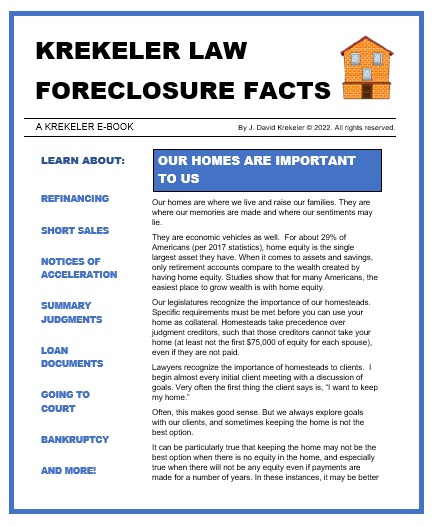The answer usually depends upon the intent and goals of the couple. If one spouse wishes to remain in the house, that spouse will have to have the financial capabilities to do so.
Refinance or sale is always an option, but it is not always possible to do so. Typically, a divorce order might order the spouse retaining the home to hold harmless and indemnify the other spouse from any loss. One option is for the residing spouse to continue to make the mortgage payments. On a long-term loan, such as a 30-year amortization, this is usually not a problem. It can become a problem, though, if the loan matures in a year or two and the lender wants both spouses to remain liable upon the Note.
These situations are often accompanied with bankruptcy or the threat thereof. Lenders will usually be willing to re-write the Note with a single spouse rather than face the prospect of having to foreclose and possibly take a loss on the property.
Bankruptcy may also afford the opportunity to eliminate any junior liens on the property. That is likely a topic for a different column.
If the residing spouse cannot actually afford the regular mortgage payment, loan modifications may be available, depending upon the lender and its policies. Such modifications are far more common today than they were 7 or 8 years ago.
Even if a loan modification cannot be obtained, the residing spouse should not vacate the premises. The amount of time the spouse will be able to remain in the home, even without paying, varies by state law, but is usually significant. Here in Wisconsin, we advise our clients that we can keep them in the home relatively easily and inexpensively for at least a year following their default.
Foreclosure also provides additional loan modification opportunities. Again, procedures vary from state to state, and perhaps even inside a particular state. Mediation programs are fairly common place here in Wisconsin. With a mediation, the borrower and the lender will at least meet to discuss options. Those discussions often lead to agreements.
The final option would be bankruptcy. Again, procedures vary from court to court. Both districts’ Federal court here in Wisconsin have mortgage mediation programs. While lenders are not required to participate, most do, and the success rate is slightly over 70%. Success does not mean that the borrow gets all the terms they request, but that at least some modification offer is obtained.
I believe the steps that a divorcing couple should take would be as follows:
- Decide who wants the home.
- Evaluate the financial ability to retain the home, anticipating what the divorce judgment is likely to require in the form of payments, such as child support, maintenance or alimony.
- Make the payments and keep the house. –OR-
3a. Negotiate a loan modification under one of the plans described above.
- If all else fails, extract equity from the home in the form of living there without payment for as long as possible.
Contact Krekeler Strother today if you find yourself asking, “Who Gets the House?”

